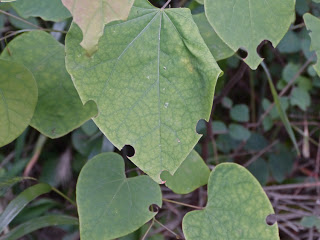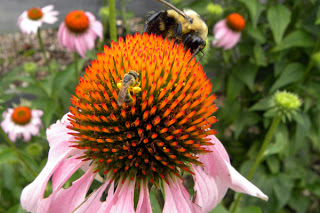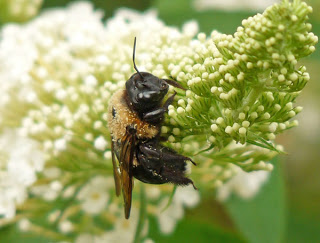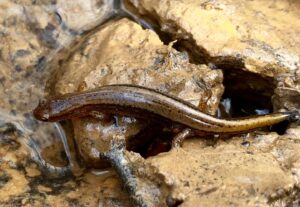You never know the questions that may arise from a simple walk in the woods. Last week, I visited the Morgan Conservation Park in Oldham County for the first time. Our target was the nightjars known to live there. Nightjars? The family to which Whip-Poor-Wills and Chuck-Wills-Widow belong – in other words, birds that sing at night. We found a redbud tree with the oddest thing – it looked like some bug with a hole puncher had taken bites out of the leaves. I’ve never seen this before, and sent it around to other nature friends.
Turns out that these holes were chewed by a leaf-cutter bee. What? Yes, a native bee species. It’s time to investigate bees a little more. I knew that sometimes it’s hard to tell bees and flies and wasps apart, but I was astonished to learn about native bees! Some bees are “solitary,” not living in hives with a queen like the honey bees do. Both males and females work for a living. This leafcutter digs a burrow in the ground, and uses the leaf pieces to separate each egg chamber from the next.
We are familiar with honey bees, and the problems they are having these days. But did you know they are not native to the New World? Honey bees arrived with European settlers about 400 years ago. Read this terrific brochure from the USDA about native bees. For example, there are over 4,000 different species of native bees in the United States! Many of our native bees are quite specialized, such as the blueberry bee or the squash bee.
| Bees or Wasps? Upper left: An eastern yellow jacket wasp Lower left: The familiar black and yellow mud dauber wasp Upper right: A digger bee, Lower right: The nomad bee |
Bees are descended from wasps. Most wasps are carnivores; they either prey upon or parasitize other insects or spiders, and use this rich protein source to feed their young. About 125 million years ago, when the first flowering plants evolved, some wasps made a switch from hunting prey to gathering pollen for their brood. Perhaps they were hunting for insects that visited flowers and ate some of the pollen or drank the nectar along with their prey. It didn’t take much to find the advantages of consuming pollen over hunting. Pollen is rich in proteins and doesn’t fight back, so it is easy to imagine why the bees became vegetarians. Gathering pollen and nectar requires certain adaptations different from those of hunters, so they started to change, to evolve to meet these requirements and consequently became bees.
How to tell the difference between honey bees and bumble bees, the two most familiar bees?
Carpenter bees are a native species with a bad reputation. They have powerful jaws called mandibles with which they can excavate tunnels in wood. Fortunately they prefer soft wood and dislike paint or other finishing materials. It is possible to prevent them from doing serious damage to wood structures by taking simple precautions, such as painting or staining the wood. These gentle giants are called carpenter bees, and very likely you have seen some of them and their handiwork. There is usually a pile of sawdust below the opening of the hole during the early nesting and burrow excavation season. These bees create “particle board” spiral partitions between adjacent cells. Most bees construct spiral partition cell closures, a trademark of bees rather than wasps.
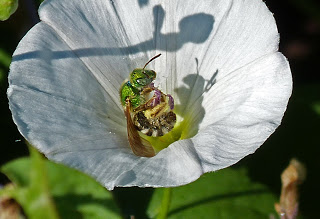 |
| Green Metallic Bee – Agapostemon splendens |
Some of the most beautiful bees belong to the sweat bee family. With their shiny metallic-colored bodies, these bees will capture your heart. Many are metallic green, but others have shades of color from blue to copper or gold, and sometimes even black. Most nest in the ground. Some are solitary while others share the entrance to their nests. In most cases, that is all they share and are not truly social. This little green guy was careful to wiggle all around the inside of this morning glory to get all the pollen.
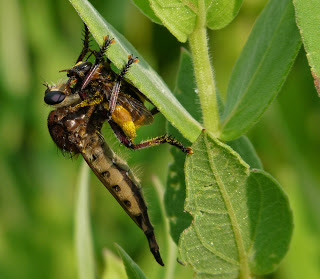 |
| Robber Fly with Bee Prey |
Once while watching a little bee with big pollen sacks, we saw what appeared to be a large wasp attack and kill it.
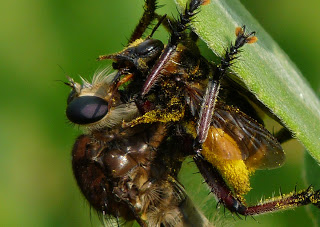 |
| Robber Fly |
Further research found that this was in fact a robber fly. And you thought flies were only interested in garbage and manure! There are two simple ways to tell a fly mimic from a bee. First, look at the wings: bees have four wings, but flies have two wings. Second, look at the antennae: bees have elbowed antennae, while many flies have short, stubby, or hair-thin antennae. If you can’t see the antennae, you’re probably looking at a fly. A site called Beespotter has lots of great info on bees and bee look-alikes.

